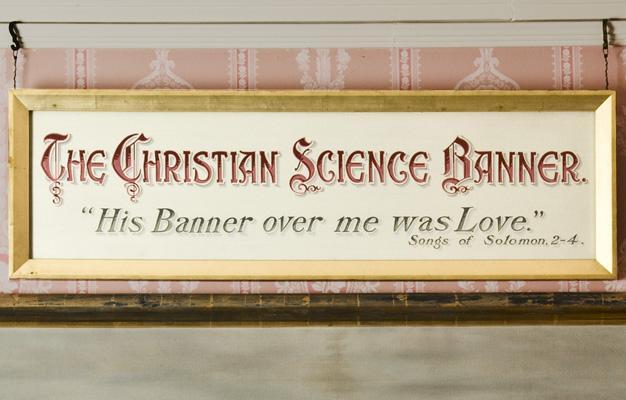Contemporary photograph of the banner hanging over Daniel E. Fultz’s tapestry
painting, at Mary Baker Eddy’s home in Chestnut Hill, Massachusetts.
On May 17, 1901, Daniel E. Fultz of Spokane, Washington, wrote to Mary Baker Eddy. “[W]ill you accept this tapestry painting from me,” he asked, “who shall ever feel your debtor, for all that truth has done for me, this blessed Christian Science.1
Fultz’s “tapestry painting,” in oil paint on fabric, is quite large—82 inches high by 56 inches wide. It depicts Jesus Christ holding a lamb and is modeled after a painting titled “The Good Shepherd” by German artist Bernhard Plockhorst (1825–1907).
 Tapestry painting hanging in Eddy’s parlor in Concord, New Hampshire, c. 1901–1905. P06246. |
Eddy was impressed with the painting. And in a May 23 reply, she thanked Fultz:
May the blessings you have received from Christian Science continue, and increase; may the light be clearer to you which reflects the beauties of holiness and the scenes of spiritual joys be lifted upon your vision, and the tender Christ take you in his arms and carry you to the fold of Truth – as gently as you depict this in painting.2
After consulting with Fultz regarding the proper way to hang the painting, Eddy decided to display it from a roller and add fringe to the bottom edge. To further illustrate its significance to her, she had a placard created to hang with it.
On July 28 she wrote again to Fultz:
…I almost kneel before that shrine of my heart.
I have hung above it a gilt frame with this lettering on it.
The Christian Science Banner.
“His banner over us was love”
Solomon’s Songs.
All who visit my house are shown your painting.3
 Contemporary photograph of the painting as it hung at Eddy’s Chestnut Hill home. |
A banner can be defined as anything regarded or displayed as a symbol of principles. Eddy identified this painting as an expression of the principles she held dear and wished others to value. “The Christian Science Banner” remained a focal point at her homes in both Concord, New Hampshire, and Chestnut Hill, Massachusetts.


